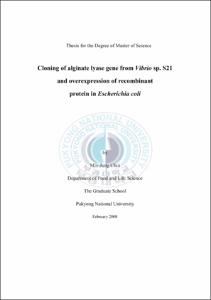Cloning of alginate lyase gene from Vibrio sp. S21 and overexpression of recombinant protein in Escherichia coli
- Alternative Title
- Vibrio sp. S21 로부터 알긴산 분해효소 유전자의 클로닝과 대장균에서의 재조합 단백질 과발현
- Abstract
- 알긴산은 갈조류의 세포벽을 구성하는 다당류로 mannuronic acid와 guluronic acid로 구성되어 있으며, 점성을 가지는 특성으로 인해 식품과 의약품 산업에 광범위하게 이용되고 있다. 또한 혈중 콜레스테롤, 지질의 감소로 인한 항비만 효과, 대식세포의 식작용 활성 증진 및 면역력 강화로 인한 항암효과 등의 기능성이 보고되어 있다. 최근에는 이들 알긴산을 분해하여 얻은 올리고당이 이러한 생물학적인 효능이 더 높다는 보고가 있어 더불어 효소를 이용한 알긴산 분해에 관한 연구가 다양하게 진행되고 있다. 본 연구는 저분자화 알긴산 생산의 기초를 마련하고자, 해양 미생물 Vibrio sp. S21로부터 알긴산 분해 효소 유전자를 분리 및 클로닝하여 재조합 알긴산 분해효소의 대량생산 시스템을 구축하였다.
16s rRNA sequence를 이용하여 Vibrio sp. S21로 동정된 균주로부터 알긴산 분해 효소 유전자를 클로닝하고 서열을 분석한 결과 1,017 bp의 open reading frame으로 338개의 아미노산 잔기를 함유하는 38.4 kDa의 분자량을 나타냄을 알 수 있었다. 이 서열은 Vibrio sp. QY101 균주로부터 생산된 알긴산 분해효소의 nucleotide 서열과 99% homology를 보였다. E. coli에서 재조합 효소의 발현을 위해 알긴산 분해효소 유전자를 expression vector인 pTrc vector에 삽입하여 5,193 bp의 재조합 플라스미드를 얻었다. E. coli에서 재조합 알긴산 분해 효소의 최적 발현 조건으로 induction 온도는 20℃, IPTG 농도는 0.2 mM로 나타났고, 동일한 조건에서 6시간 동안 induction한 균체와 15시간 induction한 배양액에서 알긴산 분해효소의 높은 활성이 나타났다. 알긴산 분해효소를 정제하기 위해 Q-Sepharose 이온 교환 크로마토그래피와 phenyl-Sepharose 소수성 상호작용 크로마토그래피를 이용하였고, 최종적으로 55% 수율과 46배의 정제도를 나타냈으며, 정제된 효소는 SDS-PAGE에 의해서 분자량이 34 kDa으로 측정되었다. 이는 서열분석에서 ORF의 이론적인 38.4 kDa 분자량과 상이한 결과를 나타내어 정제된 효소로부터 N-terminal peptide를 분석한 결과 KSEQA로 나타났다. 이 결과로 ORF로 코딩된 338개의 아미노산 중 M1부터 A^(50)까지 50개의 아미노산이 signal peptide로 잘리면서 posttranslational modification이 일어난 것으로 판단되었다. 재조합 알긴산 분해 효소의 최적 반응 온도는 35℃이며 최적 활성 pH는 8.0로 나타났으며, 안정한 온도는 30℃까지, pH 구간은 7.5-8.0으로 나타났다. 기질 농도에 따른 효소활성을 Lineweaver -Burk plot 으로 나타낸 결과 Km값은 4.30 mM (sugar residues), Vmax값은 0.273 mM/min로 측정되었다. Polymannuronate와 polyguluronate 두 기질에 대한 효소활성을 살펴 본 결과, Km값이 각각 4.03 mM (sugar residues), 1.31 mM (sugar residues)로 나타나, 분리된 효소는 polyguluronate 기질에 친화력이 더 높은 것으로 확인되었다.
- Issued Date
- 2008
- Awarded Date
- 2008. 2
- Type
- Dissertation
- Publisher
- 부경대학교 대학원
- Alternative Author(s)
- Choi, Min-Jung
- Affiliation
- 부경대학교 대학원
- Department
- 대학원 식품생명과학과
- Advisor
- 김형락
- Table Of Contents
- Introduction = 1
Materials and Methods = 6
1. Bacterial strains, plasmids and culture conditions = 6
2. Cloning of alginate lyase gene from Vibrio sp. S21 = 7
2.1. Bacterial genomic DNA extraction = 7
2.2. Amplification and cloning of alginate lyase gene = 7
2.3. Preparation of competent cell = 9
2.4. Transformation = 9
2.5. Plasmid DNA extraction = 11
2.6. Sequence analysis = 11
2.7. Subcloning of alginate lyase gene with pTrc expression vector system = 12
3. Overexpression and purification of recombinant alginate lyase = 14
3.1. Overexpression of recombinant alginate lyase = 14
3.1.1. Effect of temperature = 14
3.1.2. Effect of IPTG concentration = 14
3.1.3. Effect of induction times = 14
3.2. Purification of recombinant alginate lyase = 15
3.2.1. Purification of recombinant alginate lyase = 15
3.2.2. Determination of protein concentration = 15
3.2.3. Alginate lyase activity assay = 15
4. Characterization of purified alginate lyase = 17
4.1. Determination of the molecular weight = 17
4.2. N-terminal amino acid sequence = 17
4.3. pH dependence and stability = 17
4.4. Temperature dependence and stability = 18
4.5. Determination of Kinetic Parameters = 18
4.6. Substrate specificity = 18
Results and Discussion = 20
1. Cloning of alginate lyase gene from Vibrio sp. S21 and sequence analysis = 20
2. Overexpression of recombinant alginate lyase in E. coli = 27
3. Purification of recombinant alginate lyase = 33
4. Characterization of purified recombinant alginate lyase = 37
Reference = 48
- Degree
- Master
- Files in This Item:
-
-
Download
 Cloning of alginate lyase gene from Vibrio sp. S21 and overexpression of recombinant protein in Esch.pdf
기타 데이터 / 955.71 kB / Adobe PDF
Cloning of alginate lyase gene from Vibrio sp. S21 and overexpression of recombinant protein in Esch.pdf
기타 데이터 / 955.71 kB / Adobe PDF
-
Items in Repository are protected by copyright, with all rights reserved, unless otherwise indicated.